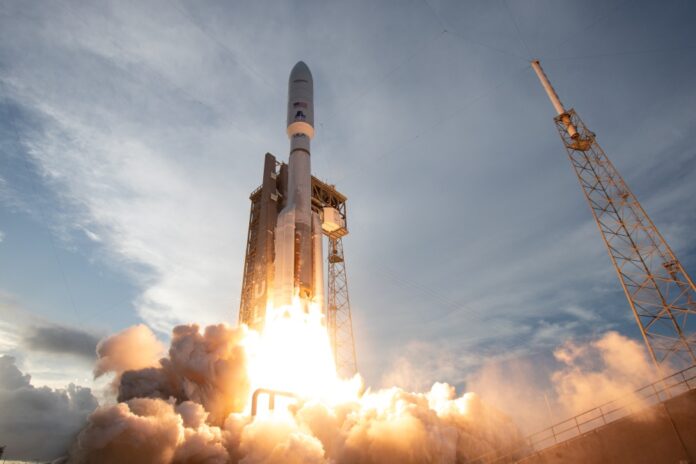Only 3,209 more to go…will Starlink’s first-mover advantage give it too much of a lead?
The first 27 satellites of Amazon’s Kuiper long-planned broadband internet constellation finally launched into space from Florida on Monday at midnight BST (7pm local time).
The Kuiper constellation will eventually comprise 3,236 spacecraft operating in low-Earth orbit (LEO). It will compete against Elon Musk’s Starlink constellation as well as other satellite service providers.
Project Kuiper is a $10 billion initiative announced by Amazon announced in 2019 to provide broadband around the world to individuals, businesses and the public sector in not-spots and as a back-up when terrestrial infrastructure fails.
The clutch of 27 LEOs were fired into space from Cape Canaveral Space Force Station on top of an Atlas V rocket from the joint venture between Boeing and Lockheed Martin, the United Launch Alliance (ULA). The picture shows the launch: Atlas V Kuiper 1, provided by ULA.
Running behind the rocket
The original launch date was 9 April, but bad weather put a stop to that and, in the scheme of things, is nothing: Amazon’s original plan was to launch the inaugural batch early last year. Indeed the delays have been such that the company is now under time pressure. It has a deadline, set by US regulator the Federal Communications Commission, to launch half the satellites, that is 1,618 units, by the middle of next year.
Commentators think Amazon will apply for an extension.
Next steps
The next step is for the company to confirm initial contact with all of the satellites from its mission operations centre in Redmond, Washington. Assuming all is well, Amazon says it intends to start offering service to customers later this year.
According to a report by Reuters, ULA could launch up to five more Kuiper missions this year and, citing a 2020 FCC filing, suggested the company could begin service in some northern and southern regions when 578 satellites are operational. It will gradually expanding coverage towards the equator as the more Kuiper satellites go into orbit.
In 2022, Amazon booked 83 rocket launches from ULA, France’s Arianespace and Blue Origin, Bezos’ own space company. Amazon launched two prototype satellites in 2023 which apparently were successful in tests and that were taken out of orbit last year.
Will Kuiper succeed?
Although Project Kuiper lags SpaceX in terms of launches and operations, Amazon has argued that its experience of consumer products plus and its AWS cloud computing business with which Kuiper will connect gives it an edge over Starlink.
Amazon showed off its Kuiper consumer terminals back in 2023 – an antenna the size of 12 inch vinyl record and an even smaller one about the size of its Kindle ebook reader. Amazon said it expects to produce tens of millions of the devices for under $400 each.
Further, Jeff Bezos, one of Amazon’s founders and Executive Chair, seems to think there is room in the market for everyone. He was quoted in an interview with Reuters earlier this year stating there is “insatiable demand” for internet access.
In February, the UK’s communications regulator, Ofcom granted an earth station network licence to Amazon Kuiper Services Europe. In September 2023, Vodafone and Vodacom announced they will use Project Kuiper’s constellation to extend the reach of their 4G and 5G networks in Europe and Africa.
Starlink’s pros and cons
On the other hand, SpaceX is both a satellite operator and launch company. Its reusable Falcon 9 rocket has put more than 8,000 Starlink satellites in orbit since 2019. It celebrated its 250th dedicated Starlink launch on Monday and is currently carrying out at least a launch every week to put about 24 satellites into orbit.
Starlink has about 5 million customers in 125 countries, and even recruited military and intelligence agencies as customers.
However, Musk’s antics in recent weeks, his alleged interference in the war in Ukraine, and his close relationship with President Trump might give some pause for thought. And as Tesla is showing, first mover advantage is no guarantee of permanent leadership in a market.



